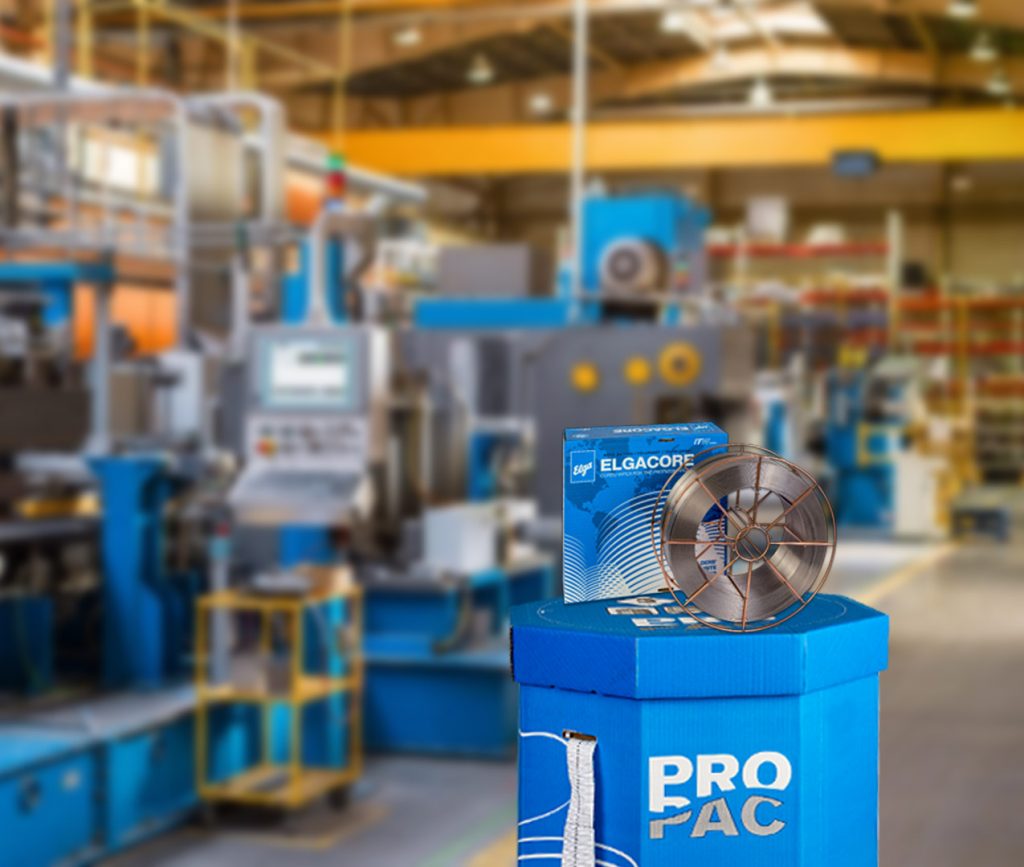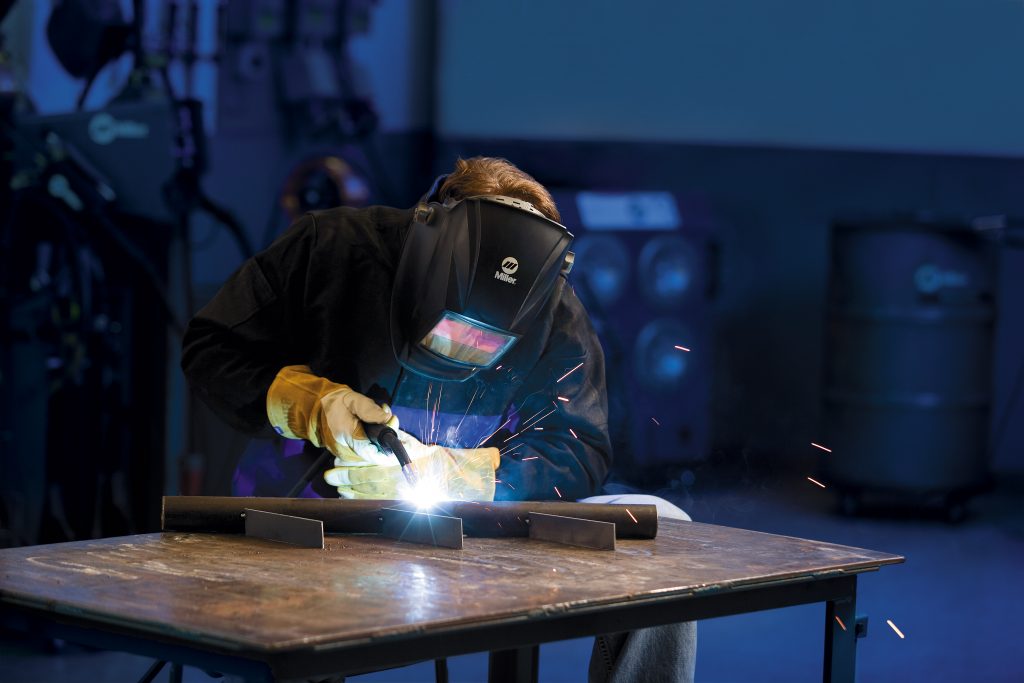MIG Troubleshooting for Metal-Cored and Solid Wire
MIG welding (also known as GMAW) is a popular process because of the productivity, reliability and ease of use it offers. However, issues can arise if a welder doesn’t use proper technique and parameters or perform proper equipment setup and maintenance. To help reduce lost productivity and downtime costs, it’s important to know how to quickly identify and solve issues like porosity, undercut, excessive spatter and more. Here are tips to identify and correct problems associated with using both metal-cored wire and solid wire in the MIG welding process.
Issue 1: Porosity
The most common cause of porosity when MIG welding is poor shielding of the weld pool, leading to contamination by atmospheric gases. Poor shielding occurs when the shielding gas flow is restricted, turbulent or insufficient.
Environmental factors such as wind can displace gas flow. It is best to relocate to an area with less wind, but screens can be used if they can reduce wind velocity in the welding area to 8 kilometers per hour (kph) at most.
Spatter buildup in the nozzle can also cause a turbulent or restricted flow. Be sure to periodically check the nozzle for excessive spatter buildup; if present, remove this buildup with welder’s pliers. While the nozzle is removed for cleaning, ensure that the diffuser’s gas ports are unobstructed.
An insufficient flow typically results from setting the shielding gas flow meter incorrectly or using too small of a welding nozzle diameter for the weld pool being created. A flow rate of 15 to 22 l/min is often recommended when welding using a spray transfer. Welds that use higher amperages may require a higher flow rate. Be aware that excessive flow rates (especially relative to the nozzle diameter being used) and nozzle obstructions can lead to turbulence, which can introduce atmospheric gases into the shielding gas column.

Base metal contamination with oil, grease, mill
scale, rust or moisture can lead to welding porosity.
While metal-cored wire better tolerates base metal
contamination than solid wire does, it’s still important
to properly clean the material before welding.
When using solid wire with a short-circuit transfer process, welders can use lower flow rates — approximately 12 to 15 l/min — and still adequately shield the weld. The lower voltages and amperages of the short circuit transfer produce smaller weld pools that require less shielding gas to protect them from the atmosphere.
Base metal contamination with oil, grease, mill scale, rust and/or moisture can also lead to welding porosity. While metal-cored wire often better tolerates base metal contamination than solid wire does, it’s still important to properly clean the material of excessive contaminants before welding. Remember to store welding wires in a clean, dry place with a temperature similar to the welding environment; doing so minimizes the risk of condensation that can contaminate the material.
Issue 2: Undercut
Undercut can be created when the welder focuses the arc too much on the bottom plate and not enough on the top plate of the weld joint — in other words, when the welder uses an incorrect gun angle. Other common causes are excessive voltage and travel speeds that are too fast without using enough filler metal. If undercut is happening toward the end of the joints, arc blow (or arc wander) may be the cause.
Voltage influences arc force. When voltage is too high, it can cause the arc to want to push the molten weld pool out of the way. It also results in a more fluid pool with less surface tension that helps fight the pull of gravity to maintain an appropriate bead shape. Reducing the travel speed and increasing wire feed speed to ensure there is sufficient wire to fill the joint and areas gouged by the arc can help combat undercut. Pausing longer at each side of the weld bead when using a weave technique can also help.
To reduce the effects of arc blow, try moving the work lead clamp (often called the ground) to a different spot.
Issue 3: Weld spatter
A short-circuit transfer will always create higher spatter levels than a spray transfer. To generate minimal spatter levels and achieve maximum travel speeds, use sufficiently high voltages and wire feed speeds to obtain a spray transfer whenever possible. A voltage that is too low in relation to the wire feed speed is the most common contributor to excessive spatter levels, regardless of the transfer being used. Ideally, voltage should be high enough to minimize spatter, but not so high as to cause undercut.

The MIG welding process — whether it uses solid wire
or metal-cored wire — can be prone to common pitfalls.
To help reduce the downtime and costs associated with
troubleshooting, it’s important to know how to quickly
identify and solve issues.
MIG welding can tolerate some degree of base metal contaminants (particularly when using metal-cored wire) but the presence of base metal rust or mill scale increases the amount of spatter generated in addition to increasing the risk of porosity. Minimizing spatter is a matter of balancing the acceptable level against the time spent cleaning the base metal.
Spatter levels can also be influenced by shielding gas and wire selection. A 75% argon/25% carbon dioxide gas mixture typically results in less consistent transfer that generates more spatter than a 90% argon/10% carbon dioxide mixture. All other things being equal, metal-cored wire generally has a smoother arc that produces less spatter than solid wire.
An uncontrollable, erratic arc that generates high amounts of spatter repeatedly in one area of the weld/part is a typical symptom of arc blow. It can often be corrected by moving the work clamp or changing travel direction with respect to the work lead clamp.
Issue 4: Lack of fusion and poor penetration
Metal-cored wire typically provides a wider penetration profile than solid wire, making it easier to achieve fusion into the side walls of the weld and avoid lack of fusion in these areas. However, issues can still arise if the welding procedure and technique used are not optimized.
Welding current that is too low is the most common cause of lack of fusion. The amperages required to run a spray transfer mode with MIG welding typically help prevent lack of fusion. Stay out of the globular and short-circuit transfer ranges, which do not offer significant penetration.
„Riding the pool“ may be a cause, too. This happens when travel speed is too low for the wire feed speed and voltage selected so that the weld pool forms and/or flows significantly ahead of the wire. To prevent the issue, stay on the leading edge of the weld pool to maximize penetration and sidewall fusion. To stay on the leading edge without changing travel speed, reduce the wire feed speed. Conversely, to stay on the leading edge without changing the wire feed speed, increase the travel speed.
Running too small of a wire diameter can be another cause of fusion or penetration issues. Smaller wire diameters typically form narrower arc cones that may be too narrow and unable to spread out the molten filler metal. Larger diameter wires have lower deposition rates for the same amperage compared to smaller diameter wires, but offer a wider arc cone that assists fusion into the sidewalls. Larger diameter wires also allow welders to weld at higher currents with good arc stability; this is helpful if the current can no longer be increased while maintaining good weld quality when using a smaller diameter wire.
Welder technique and travel angle can also affect weld fusion. With solid and metal-cored wires, a push angle is typically used, but an excessive push angle can reduce penetration. Poor penetration in MIG welding can also be caused by joint design. It can help to open up the bevel angles of the joint or use a wider root opening.

with a temperature similar to the welding environment;
doing so minimizes the risk of condensation that can
contaminate the material.
Issue 5: Overlapping (cold lap)
Overlapping, also called cold lap, happens when the filler metal doesn’t fuse into the base material at the weld toes.
As with many other welding defects, this problem is often the result of multiple simultaneous factors. Overlap may be caused by riding the weld pool while adding too much filler and having insufficient voltage to spread the weld pool to the appropriate width. This problem can be remedied by increasing voltage and travel speed and reducing wire feed speed. Remember, it’s important to always stay on the leading edge of the weld pool for optimum weld penetration and quality.
Proper angle can also help eliminate cold lap. Welders should be sure to distribute the arc cone equally between the two base plates of a weld joint, assuming there is equal material thickness. One benefit of metal-cored wire is that the wider arc cone helps spread the weld metal out, so it’s more forgiving to variations in work angle than solid wire, which can help minimize the risk of cold lap.
Issue 6: Weld cracking
Both metal-cored and solid wires generally have low hydrogen levels and are resistant to moisture pickup that can contribute to hydrogen-induced weld cracking. However, cracked welds can be caused by numerous other factors, too. These include insufficient weld size, excessive joint restraint, poor joint design or a rapid weld cooling rate. Cracked welds can also result when the filler metal chemical composition is incompatible with the base material or the tensile strength and ductility of the filler metal doesn’t match the base metal or the application demands.
Adjustments can be made to weld procedures to obtain higher weld ductility and help prevent cracking. Shielding gas selection, for example, impacts ductility. Shielding gases with higher argon content (example: 90% argon/10% carbon dioxide) tend to offer smoother arc characteristics than lower argon shielding gas mixtures. They also tend to increase tensile strength, which can reduce weld metal ductility.

spatter or lack of fusion — can often be done with some
simple changes to joint design, welding technique or parameter
settings.
It is important to adjust the weld size to match the part thickness, reduce the weld cooling rate through the use of preheat, and reduce joint restraint through proper design. Very narrow, deep joints on thicker materials increase crack sensitivity, whether using solid wire or metal-cored wire.
Issue 7: Distortion
Welding distortion can be caused by many factors, but one likely culprit is part design or faulty joint preparation that requires additional weld volume. Making changes to design can help reduce distortion. For instance, instead of tack welding a 90-degree T joint, tack weld the parts slightly off square. This incorporates distortion during welding into the as-designed dimensions. Fitting the part to compensate for the distortion is often called presetting the joint. Intentionally bending parts before welding to compensate for distortion is often called precambering the joint.
Heat input is reduced when amperage and voltage are decreased and/or travel speed is increased. Minimizing heat input can help limit distortion. Metal-cored wire offers advantages over solid wire because it can provide a lower heat input (due to lower amperage) for the same wire feed speed.
MIG welding troubleshooting
Addressing common MIG welding issues — whether porosity, undercut, spatter or lack of fusion — can often be done with some simple changes to joint design, welding technique or parameter settings.
In addition, using metal-cored wire rather than solid wire in the right applications can deliver numerous benefits that help address some of these basic MIG welding problems. In either case, knowing how to quickly identify and solve problems can help keep the welding operation on track — in terms of quality, productivity and costs.
Tags: MATRIX, MCW, MEGAFIL, Problem Solving
